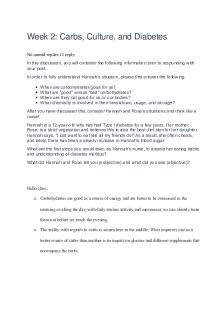Week 2 Discussion Handout PDF

| Title | Week 2 Discussion Handout |
|---|---|
| Author | Zoe Zhao |
| Course | Basic Economics II |
| Institution | University of California Irvine |
| Pages | 3 |
| File Size | 68.1 KB |
| File Type | |
| Total Downloads | 105 |
| Total Views | 166 |
Summary
Practice questions for materials go over in week 2....
Description
Practice Questions: 1. (True/False) The GDP deflator reflects the prices of goods and services bought by consumers, the consumer price index reflects the price of all final goods and services produced domestically.
2. (True/False) The consumer price index compares the price of a fixed basket of goods and services to the price of the basket in the base year. On the other hand, the GDP deflator compares the price of the currently produced goods and services to the price of the same goods and services in the base years.
3. (True/False) Indexation refers to the automatic correction of a dollar amount for the effects of inflation by law or contract.
4. (True/False) Long-term contracts between firms and unions will sometimes include partial or complete indexation of the wage to the consumer price index. This is called a cost-of-living allowance clause.
5.
In the CPI, goods and services are weighted according to A. how much a typical consumer buys of each item. B. whether the items are necessities or luxuries. C. how much of each item is produced in the domestic economy. D. how much is spent on them in the international accounts.
6.
By not taking into account the possibility of consumer substitution, the CPI A. understate the standard of living. B. overstate the cost of living. C. neither overstate nor understate the cost of living. D. doesn’t accurately reflect the cost of living, but it is unclear if it overstates the cost of living.
7.
If the prices of Brazilian-made shoes imported into Canada increases, then A. both Canada’s GDP deflator and its’ consumer price index will increase. B. neither Canada’s GDP deflator and its’ consumer price index will increase. C. Canada’s GDP deflator will increase but its’ CPI will not. D. Canada’s CPI will increase, but its’ GDP deflator won’t change.
8.
If increase in the prices of imported Canada Car causes the CPI to increase by 3 percent, the US GDP deflator will likely to increase by A. more than 3 percent. B. 3 percent. C.less than 3 percent. D. neither above is correct.
9.
The real interest rate tells you A. how quickly your saving account will grow. B. how quickly the purchasing power of your saving account will grow. C. the size of your savings account. D. the purchasing power of your savings account.
10.
Inflation refers to A. a temporary increase in the price level due to higher tax rates. B. a large increase in food and gasoline prices. C. a situation in which the economy’s overall price level is rising. D. an increase in the purchasing power of the dollar.
11. If nominal interest rates increase from 8 percent to 10 percent while inflation increases from 3 percent to 12 percent A. the real interest rate falls from 5 percent to -2 percent B. the real interest rate rises from -2 percent to 5 percent C. the real interest rate falls from 12 percent to 8 percent D. the real interest rate rises from 8 percent to 12 percent
12.
If the nominal interest rate is 10 percent and the inflation rate is 3 percent, what is the real interest rate A. 13 percent. B. 7 percent. C. 3 percent. D. -7 percent.
13. If the consumer price index (CPI) at the end of 1996 was 125 and the CPI as the end of 1997 was 131. The rate of inflation during 1997 was: A. zero. B. 4.8 percent. C. 10 percent. D. 104.8 percent
14.
Frank’s nominal income in 1998 is $45,000. Suppose the CPI in 1998 is 150. What is Frank’s real
income in 1998? A. $51,750.
B. $45,000.
C. $38,250.
D. $30,000...
Similar Free PDFs

Week 2 Discussion Handout
- 3 Pages

Week 4, Discussion 2
- 3 Pages

OHS Discussion week 2
- 1 Pages

Week 2 Discussion Forum
- 3 Pages

MIMG101 Discussion Week 2
- 4 Pages

Week 2 Discussion Board
- 1 Pages

Week 2 discussion
- 5 Pages

Week 2 Discussion Forum
- 2 Pages

Week 2 Discussion
- 2 Pages

WEEK 2 Film Discussion
- 1 Pages

WEEK 2 DIscussion Post
- 1 Pages

Week 1 discussion 2
- 1 Pages

WEEK 3 Discussion 2 - notes
- 2 Pages

PHR155 Week 3 Discussion 2
- 4 Pages

Week 1 Lesson 2 Discussion
- 1 Pages

WS 311 WEEK 2 discussion
- 2 Pages
Popular Institutions
- Tinajero National High School - Annex
- Politeknik Caltex Riau
- Yokohama City University
- SGT University
- University of Al-Qadisiyah
- Divine Word College of Vigan
- Techniek College Rotterdam
- Universidade de Santiago
- Universiti Teknologi MARA Cawangan Johor Kampus Pasir Gudang
- Poltekkes Kemenkes Yogyakarta
- Baguio City National High School
- Colegio san marcos
- preparatoria uno
- Centro de Bachillerato Tecnológico Industrial y de Servicios No. 107
- Dalian Maritime University
- Quang Trung Secondary School
- Colegio Tecnológico en Informática
- Corporación Regional de Educación Superior
- Grupo CEDVA
- Dar Al Uloom University
- Centro de Estudios Preuniversitarios de la Universidad Nacional de Ingeniería
- 上智大学
- Aakash International School, Nuna Majara
- San Felipe Neri Catholic School
- Kang Chiao International School - New Taipei City
- Misamis Occidental National High School
- Institución Educativa Escuela Normal Juan Ladrilleros
- Kolehiyo ng Pantukan
- Batanes State College
- Instituto Continental
- Sekolah Menengah Kejuruan Kesehatan Kaltara (Tarakan)
- Colegio de La Inmaculada Concepcion - Cebu